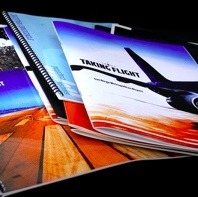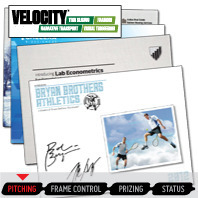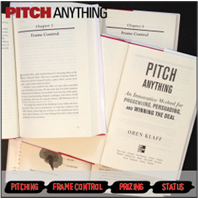Oren Klaff's Blog
October 22, 2012
Pitch Anything on Chase Jarvis LIVE : How to Pitch Creative Products & Services
Watch the replay video of Oren on the Chase Jarvis LIVE show where he discusses how to pitch creative services to command higher rates in industry tiers, how to avoid getting crammed down and how to make YOU and YOUR WORK become “the prize”.
If you like what you see, and want more, here is a link to the follow-up webinar video on How to Pitch Your Creative Services.
October 18, 2012
How to Restart a Dead Deal
I first met Derrick when he contacted us by email:
Oren,
I’m hustling to get a job with a large health business as their Creative Director.
Sent a note to the CEO. Went in with a prize frame. Like gangbusters got a very positive response from both the CEO and the COO within the hour saying they would like to meet with me.
Then, nothing. Radio silence. It’s a bummer because I’ve done my research and I could crush this job.
Any thoughts on how to follow up without conveying neediness?
If this situation hasn’t happened to you … don’t worry, It Will. It happens to me frequently. Why? Because as you become better at giving a pitch, you’ll be playing at the highest level of business. And the folks on level – CEO’s, investors and bankers – are busy. While they get excited about new ideas quickly, almost as fast, something new and even more interesting enters their field of view, and they have moved on to the next thing. Truth is, the CEO of a growing company will pay attention to whatever flashy object is in front of his face. This behavior is also found in toddlers, where it’s called “object impermanence”, You can see this part of human nature when a child has reached for an object that is partially hidden, indicating knowledge that the whole object is still there. However, if the object becomes completely hidden, the child makes no attempt to retrieve it. He forgets that it ever existed.
Recognizing this out-of-sight-out-of-mind part of human nature and breaking it down into such simple terms helped me understand a crucial dealmaking concept: If you receive initial excitement about your deal, but are now being ignored, the deal is not dead. It can be restarted. But you must clearly identify what is causing the problem: you have low status and a weak frame. Not only is your frame weak, you have lost frame control. (A frame is the way your brain mentally packages your power, authority, strength, information, and social status)
Listen to the brief call I had with Derrick, in which I helped him how to use the Moral Authority Frame to restart his dead deal.
Below is a copy of the exact email I wrote for Derrick. It’s short and direct, but don’t mistake that for simple. There’s a lot of sophisticated framing here:
Susan, John [the company's CEO] had contacted me on 10/9 about getting together for 15-20minutes, and neither of us did a very good job of locking it down. Probably best to calendar this through you. Can you set up a call next week tuesday or wednesay. I can do a short call mid-morning on either.
Derrick
And here’s the email I told Derrick to send to their CEO:
John, have been on a large assignment for Chevrolet, sorry I couldn’t meet with you earlier, but am back on the grid now. Let’s do a :15min call early next week, talk about your creative director needs. If it’s not right for me, I can connect you with some strong candidates.
I’ll calendar through your admin,
Regards,
Derrick
The following morning: success!
Oren,
Wanted to give you a quick update.
Sent off the script you suggested. An hour later, I have an interview scheduled for Tuesday. I really appreciate it.
Is this kind of framing universally applicable, to be used in all kinds of business/social interactions? I think it is. If you want to learn more about the framing and the STRONG method, go to pitchmastery.com and enter your email for videos and to attend our next online event.
October 8, 2012
Video: Pitching Creative Services
Your pitch matters, especially when it comes to pitching creative or client services. Watch the video below to see how the techniques in Pitch Anything can help you do just that.
Link: PitchMastery.com
September 4, 2012
Where do you find investors for your deal
Here is a video of Oren’s discussion to a group of entrepreneurs at the Founders Institute on where to find investors.
July 13, 2012
Reframing the Competition (audio)
Listen to this segment from week 5 of our Pitch Mastery acceleration call on how to reframe your competition. It’s important to create a HIGH CONTRAST between your product/service and that of the competition. (Listen time 16:38). Contains strong language.
Tell me what you think below.
July 11, 2012
Why We Film Our Content in a Hollywood Studio: Reason #1 of 10
REASON 01: The Aesthetic-Usability Effect
Take a look here at the behind the scenes shot from our new video series. This was taken with a robotic boom camera, and shows off the killer set design by David Saint. He took advantage of the the aesthetic-usability effect: the important truth that aesthetic designs are perceived as better and higher quality than less-aesthetic designs.
This perception tends to exist whether or not a service is actually easier to use. And it’s not just a mind-game, because perception is an important part of the user experience (and the two are inexorably connected in the brain). The aesthetic usability effect has been replicated in social science experiments, and has important implications for the acceptance, use and performance of any service you might have. Here’s one way to think about it.
In the early days of the personal computer, all the display screens were black and white. When color screens were first introduced, they were amber or green. Green text (instead of white text) color added no discernible value for everyday work. But when people first saw a monitor with green or amber text instead of white, they wanted one. It just seemed better. THEN, color monitors came out. Since all games and software sucked at that time, from a cognitive point of view, the color added no value that could not be provided with the use of shading on a regular monitor. But despite the fact that the interface community could find no scientific benefit, people insisted on buying color monitors. For some reason, color was fulfilling a need, but one that could not be measured.
Not only are aesthetic designs easier to use, they also have a higher probability of being used. So even if something is designed in a very user-friendly way, if it is not aesthetically pleasing it is less likely to be used, making it’s usability of less value.
The rule means that first impressions count. For instance, humans who are more attractive tend to be perceived and treated better, as their initial impact influences the formation of attitudes and perceptions of others.
We build this professional presentation environment in a real studio, with professional cameras and a robotic book to create a positive perception for our new video series, Pitch Mastery.
David and I discussed the cost of the set and the production, more than $25,000 for a single day, and whether it would be worth the investment. In the end, we concluded that aesthetic designs encourage positive feelings such as patience, loyalty and affection, and we wanted those feelings around our product. We felt it would lead to much greater long term usability and that people would learn my material more easily when presented this way. These positive perceptions – we believed – would also encourage creative thinking and problem solving, whereas less aesthetic studio (like a Skype recording) would lead to negative feelings and tend to narrow thinking, and stifle the feeling of wanting from my audience.
The aesthetics of a product have far reaching consequences. The desire to posses attractive items is an innate part of the human condition and we should use this to help our businesses. I spend an enormous amount of time considering my pitches and how they look, sound and feel. Anattractive product will be perceived as easier to use. Ease of use is often a criteria in purchase decisions – easy to use products require less training and support. So by improving the attractiveness of a pitch, it increases the perceived high-quality of a deal – improving the chances of getting a deal done.
Spending time and money on the outward appearance of your product, pitch or presentation makes a lot of sense and that it can more than pay for itself in increased sales volume or users. So, if users are complaining that your product isn’t user friendly, your training is boring, or your pitch is too long and detailed, it might not be a problem with you, the product or your interface mechanics – it might be their way of saying that what you’re presenting them just it isn’t attractive enough, and that they don’t WANT it.
10 REASONS WE SPEND THE MONEY TO FILM IN A HOLLYWOOD STUDIO AND MAKE OUR VIDEO LOOK SO AWESOME
REASON 01: The Aesthetic-Usability Effect
 Take a look here at the behind the scenes shot from our new video series. This was taken with a robotic boom camera, and shows off the killer set design by David Saint. He took advantage of the the aesthetic-usability effect: the important truth that aesthetic designs are perceived as better and higher quality than less-aesthetic designs. This perception tends to exist whether or not a service is actually easier to use. And it’s not just a mind-game, because perception is an important part of the user experience (and the two are inexorably connected in the brain). The aesthetic usability effect has been replicated in social science experiments, and has important implications for the acceptance, use and performance of any service you might have. Here’s one way to think about it.
Take a look here at the behind the scenes shot from our new video series. This was taken with a robotic boom camera, and shows off the killer set design by David Saint. He took advantage of the the aesthetic-usability effect: the important truth that aesthetic designs are perceived as better and higher quality than less-aesthetic designs. This perception tends to exist whether or not a service is actually easier to use. And it’s not just a mind-game, because perception is an important part of the user experience (and the two are inexorably connected in the brain). The aesthetic usability effect has been replicated in social science experiments, and has important implications for the acceptance, use and performance of any service you might have. Here’s one way to think about it.
In the early days of the personal computer, all the display screens were black and white. When color screens were first introduced, they were amber or green. Green text (instead of white text) color added no discernible value for everyday work. But when people first saw a monitor with green or amber text instead of white, they wanted one. It just seemed better. THEN, color monitors came out. Since all games and software sucked at that time, from a cognitive point of view, the color added no value that could not be provided with the use of shading on a regular monitor. But despite the fact that the interface community could find no scientific benefit, people insisted on buying color monitors. For some reason, color was fulfilling a need, but one that could not be measured.
Not only are aesthetic designs easier to use, they also have a higher probability of being used. So even if something is designed in a very user-friendly way, if it is not aesthetically pleasing it is less likely to be used, making it’s usability of less value.
The rule means that first impressions count. For instance, humans who are more attractive tend to be perceived and treated better, as their initial impact influences the formation of attitudes and perceptions of others.
We build this professional presentation environment in a real studio, with professional cameras and a robotic book to create a positive perception for our new video series, Pitch Mastery.
David and I discussed the cost of the set and the production, more than $25,000 for a single day, and whether it would be worth the investment. In the end, we concluded that aesthetic designs encourage positive feelings such as patience, loyalty and affection, and we wanted those feelings around our product. We felt it would lead to much greater long term usability and that people would learn my material more easily when presented this way. These positive perceptions – we believed – would also encourage creative thinking and problem solving, whereas less aesthetic studio (like a Skype recording) would lead to negative feelings and tend to narrow thinking, and stifle the feeling of wanting from my audience.
The aesthetics of a product have far reaching consequences. The desire to posses attractive items is an innate part of the human condition and we should use this to help our businesses. I spend an enormous amount of time considering my pitches and how they look, sound and feel. Anattractive product will be perceived as easier to use. Ease of use is often a criteria in purchase decisions – easy to use products require less training and support. So by improving the attractiveness of a pitch, it increases the perceived high-quality of a deal – improving the chances of getting a deal done.
Spending time and money on the outward appearance of your product, pitch or presentation makes a lot of sense and that it can more than pay for itself in increased sales volume or users. So, if users are complaining that your product isn’t user friendly, your training is boring, or your pitch is too long and detailed, it might not be a problem with you, the product or your interface mechanics – it might be their way of saying that what you’re presenting them just it isn’t attractive enough, and that they don’t WANT it.
March 29, 2012
For 10 Days Only: The Art of the Big Idea
If there is one area where people pitching a deal fail to properly construct today, it is the Big Idea.
What is the big idea? In an effective pitch, you will find two instances of the Big Idea.
Within your verbal pitch.
Whereby you introduce your company, idea, initiative, or product as the solution to a developing problem. This is on page 105 of Pitch Anything.
Within your pitch deck.
Whereby you orient the audience and set the stage for the experience of the deal.
At the start of what is commonly known as an executive summary, and what we refer to at Intersection Capital as a "deck," this instance of the big idea sends signals to investors and sets the stage for what they are about to experience—and it does not presuppose interest into the deal.
The best way to understand what the big idea is, is to experience it for yourself.
For that reason, for 10 days only, you can download the following collection of successful big ideas.
Once this ten-day period is over, I will put up a follow-up post that explains the intricacies hidden within its structure, and give you a guide to create your own.
The Big Idea Compilation
Click here to download the 30-page PDF compilation of The Big Idea.
Chapter 1 – The Method
Here is the big idea: there is a fundamental disconnect between the way we pitch anything in the way it is received by our audience. You need to understand why this disconnect occurs in order to overcome it, succeed, and profit.
Below I have provided the first chapter of Pitch Anything which addresses the croc brain, how to leverage it to your benefit, and outlines the STRONG framework.
March 28, 2012
The Pitch Deck that Raised $1.4M in 7 Days
Your pitch deck matters. It speeds up your capital raise and protects your price.
This is a deal I own, and we raised the financing in 7 days. I am providing it here to the Pitch community to give you the understanding that pitch decks, while once tactical, are now strategic and a vital tool.
Download the Deal Book Here









